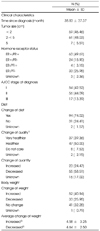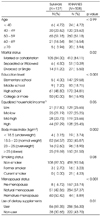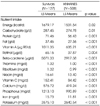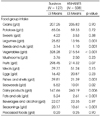Abstract
Objectives
Methods
Results
Conclusions
Figures and Tables
Table 1

Abbreviations: SD, standard deviation; ER, estrogen receptor; PR, progesterone receptor; AJCC, American joint committee on cancer.
1) Analyzed 94 cases who changed their diet after the breast cancer diagnosis
2) Analyzed 50 cases because 2 cases did not respond to the question on average weight change
3) Analyzed 33 cases
Table 2

Abbreviations: M, month; LS means, least squared means.
Adjusted for age (years, continuous), body mass index (kg/m2, continuous), marital status (married or cohabitation, others), education level (middle school or less, high school or unknown, college or more), dietary supplement use (yes or no), physical activity (MET-hour per week, continuous) and total energy intake (kcal/d, continuous). For energy intake analysis, total energy intake was not adjusted.
Table 3

Abbreviations: M, month; LS means, least squared means.
Adjusted for age (years, continuous), body mass index (kg/m2, continuous), marital status (married or cohabitation, others), education level (middle school or less, high school or unknown, college or more), dietary supplement use (yes or no), physical activity (MET-hour per week, continuous) and total energy intake (kcal/d, continuous).
Table 4

Abbreviations: LS means, least squared means.
Adjusted for age (years, continuous), body mass index (kg/m2, continuous), marital status (married or cohabitation, others), education level (middle school or less, high school or unknown, college or more), dietary supplement use (yes or no), physical activity (MET-hour per week, continuous) and total energy intake (kcal/d, continuous). For energy intake analysis, total energy intake was not adjusted.
Table 5

Abbreviations: LS means, least squared means.
Adjusted for age (years, continuous), body mass index (kg/m2, continuous), marital status (married or cohabitation, others), education level (middle school or less, high school or unknown, college or more), dietary supplement use (yes or no), physical activity (MET-hour per week, continuous) and total energy intake (kcal/d, continuous).
Table 6

Table 7

Abbreviation: LS Means, least squared means.
Adjusted for age (years, continuous), body mass index (kg/m2, continuous), marital status (married or cohabitation, separated or widowed, divorced or single, others or unknown), education level (elementary school, middle school, high school or unknown, college or more), equalized household income (low, mid-low, mid-high, high), smoking status (never-, ever-smoker, unknown), menopausal status (pre-, natural-, premature-menopause, unknown), dietary supplement use (yes or no), physical activity (vigorous and moderate, vigorous only, moderate only, no or unknown) and total energy intake (kcal/d, continuous). For energy intake analysis, total energy intake was not adjusted.
Table 8

Abbreviation: LS Means, least squared means.
Adjusted for age (years, continuous), body mass index (kg/m2, continuous), marital status (married or cohabitation, separated or widowed, divorced or single, others or unknown), education level (elementary school, middle school, high school or unknown, college or more), equalized household income (low, mid-low, mid-high, high), smoking status (never-, ever-smoker, unknown), menopausal status (pre-, natural-, premature-menopause, unknown), dietary supplement use (yes or no), physical activity (vigorous and moderate, vigorous only, moderate only, no or unknown) and total energy intake (kcal/d, continuous). For energy intake analysis, total energy intake was not adjusted.




 PDF
PDF ePub
ePub Citation
Citation Print
Print




 XML Download
XML Download